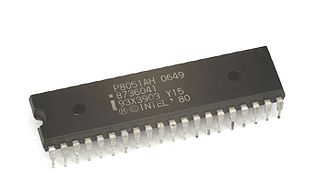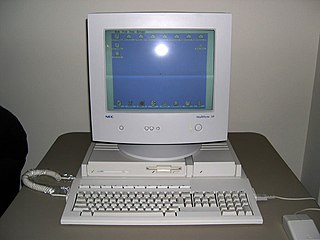
The Intel 8080 ("eighty-eighty") is the second 8-bit microprocessor designed and manufactured by Intel. It first appeared in April 1974 and is an extended and enhanced variant of the earlier 8008 design, although without binary compatibility. The initial specified clock rate or frequency limit was 2 MHz, with common instructions using 4, 5, 7, 10, or 11 cycles. As a result, the processor is able to execute several hundred thousand instructions per second. Two faster variants, the 8080A-1 and 8080A-2, became available later with clock frequency limits of 3.125 MHz and 2.63 MHz respectively. The 8080 needs two support chips to function in most applications: the i8224 clock generator/driver and the i8228 bus controller. It is implemented in N-type metal–oxide–semiconductor logic (NMOS) using non-saturated enhancement mode transistors as loads thus demanding a +12 V and a −5 V voltage in addition to the main transistor–transistor logic (TTL) compatible +5 V.

The Z80 is an 8-bit microprocessor introduced by Zilog as the startup company's first product. The Z80 was conceived by Federico Faggin in late 1974 and developed by him and his 11 employees starting in early 1975. The first working samples were delivered in March 1976, and it was officially introduced on the market in July 1976. With the revenue from the Z80, the company built its own chip factories and grew to over a thousand employees over the following two years.

The Intel MCS-51 is a single chip microcontroller (MCU) series developed by Intel in 1980 for use in embedded systems. The architect of the Intel MCS-51 instruction set was John H. Wharton. Intel's original versions were popular in the 1980s and early 1990s, and enhanced binary compatible derivatives remain popular today. It is a complex instruction set computer, but also has some of the features of RISC architectures, such as a large register set and register windows, and has separate memory spaces for program instructions and data.

The Intel 8085 ("eighty-eighty-five") is an 8-bit microprocessor produced by Intel and introduced in March 1976. It is software-binary compatible with the more-famous Intel 8080 with only two minor instructions added to support its added interrupt and serial input/output features. However, it requires less support circuitry, allowing simpler and less expensive microcomputer systems to be built. The "5" in the part number highlighted the fact that the 8085 uses a single +5-volt (V) power supply by using depletion-mode transistors, rather than requiring the +5 V, −5 V and +12 V supplies needed by the 8080. This capability matched that of the competing Z80, a popular 8080-derived CPU introduced the year before. These processors could be used in computers running the CP/M operating system.

AVR is a family of microcontrollers developed since 1996 by Atmel, acquired by Microchip Technology in 2016. These are modified Harvard architecture 8-bit RISC single-chip microcontrollers. AVR was one of the first microcontroller families to use on-chip flash memory for program storage, as opposed to one-time programmable ROM, EPROM, or EEPROM used by other microcontrollers at the time.

The MSP430 is a mixed-signal microcontroller family from Texas Instruments, first introduced on 14 February 1992. Built around a 16-bit CPU, the MSP430 is designed for low cost and, specifically, low power consumption embedded applications.
The Zilog Z800 was a 16-bit microprocessor designed by Zilog and meant to be released in 1985. It was instruction compatible with their existing Z80, and differed primarily in having on-chip cache and a memory management unit (MMU) to provide a 16 MB address range. It also added a huge number of new more orthogonal instructions and addressing modes.

The Zilog Z180 eight-bit processor is a successor of the Z80 CPU. It is compatible with the large base of software written for the Z80. The Z180 family adds higher performance and integrated peripheral functions like clock generator, 16-bit counters/timers, interrupt controller, wait-state generators, serial ports and a DMA controller. It uses separate read and write strobes, sharing similar timings with the Z80 and Intel processors. The on-chip memory management unit (MMU) has the capability of addressing up to 1 MB of memory. It is possible to configure the Z180 to operate as the Hitachi HD64180.

The HD64180 is a Z80-based embedded microprocessor developed by Hitachi with an integrated memory management unit (MMU) and on-chip peripherals. It appeared in 1985. The Hitachi HD64180 "Super Z80" was later licensed to Zilog and sold by them as the Z64180 and with some enhancements as the Zilog Z180.

The Zilog Z280 is a 16-bit microprocessor, an enhancement of the Zilog Z80 architecture, introduced in July 1987. It is basically the Z800, renamed, with slight improvements such as being fabricated in CMOS. It was a commercial failure. Zilog added a memory management unit (MMU) to expand the addressing range to 16 MB, features for multitasking and multiprocessor and coprocessor configurations, and 256 bytes of on-chip static RAM, configurable as either a cache for instructions and/or data, or as part of the ordinary address space. It has a huge number of new instructions and addressing modes giving a total of over 2000 combinations. It is capable of efficiently handling 32-bit data operations including hardware multiply, divide, and sign extension. It offers Supervisor and User operating modes, and optionally separate address spaces for instructions and data in both modes. Its internal clock signal can be configured to run at 1, 2 or 4 times the external clock's speed. Unlike the Z80 the Z280 uses a multiplexed arrangement for its address and data busses. More successful extensions of the Z80-architecture include the Hitachi HD64180 in 1986 and Zilog eZ80 in 2001, among others. See further Zilog Z800.

The Blackfin is a family of 16-/32-bit microprocessors developed, manufactured and marketed by Analog Devices. The processors have built-in, fixed-point digital signal processor (DSP) functionality supplied by 16-bit multiply–accumulates (MACs), accompanied on-chip by a microcontroller. It was designed for a unified low-power processor architecture that can run operating systems while simultaneously handling complex numeric tasks such as real-time H.264 video encoding.

The Zilog eZ80 is an 8-bit microprocessor from Zilog, introduced in 2001. eZ80 is an updated version of the company's first product, the Z80 microprocessor.

The Atari TT030 is a member of the Atari ST family, released in 1990. It was originally intended to be a high-end Unix workstation, but Atari took two years to release a port of Unix SVR4 for the TT, which prevented the TT from ever being seriously considered in its intended market.

The Low Pin Count (LPC) bus is a computer bus used on IBM-compatible personal computers to connect low-bandwidth devices to the CPU, such as the BIOS ROM, "legacy" I/O devices, and Trusted Platform Module (TPM). "Legacy" I/O devices usually include serial and parallel ports, PS/2 keyboard, PS/2 mouse, and floppy disk controller.
The original Macintosh was a relatively simple machine, now of interest for its simplicity and for the fact that it was the first computer produced by Apple under the name Macintosh. The Macintosh used standard off-the-shelf components to the greatest extent possible, achieving a moderate price point by mixing complex LSI chips, readily customizable programmable array logic, and off-the-shelf components.

The Zilog Z80182 is an enhanced, faster version of the older Z80 and is part of the Z180 microprocessor family. It's nicknamed the Zilog Intelligent Peripheral Controller (ZIP).
TLCS is a prefix applied to microcontrollers made by Toshiba. The product line includes multiple families of CISC and RISC architectures. Individual components generally have a part number beginning with "TMP". E.g. the TMP8048AP is a member of the TLCS-48 family.

The Dick Smith Super-80 was a Zilog Z80 based kit computer developed as a joint venture between Electronics Australia magazine and Dick Smith Electronics.
Zilog Encore! 32 is an ARM9-based microcontroller by Zilog, Inc. It was the company's second attempt to produce ARM-based controllers.

The P8000 is a microcomputer system developed in 1987 by the VEB Elektro-Apparate-Werke Berlin-Treptow „Friedrich Ebert“ (EAW) in the German Democratic Republic. It consisted of an 8-bit and a 16-bit microprocessor and a Winchester disk controller. It was intended as a universal programming and development system for multi-user/multi-task applications. The initial list price of the P8000 was 172,125 East German marks.
















